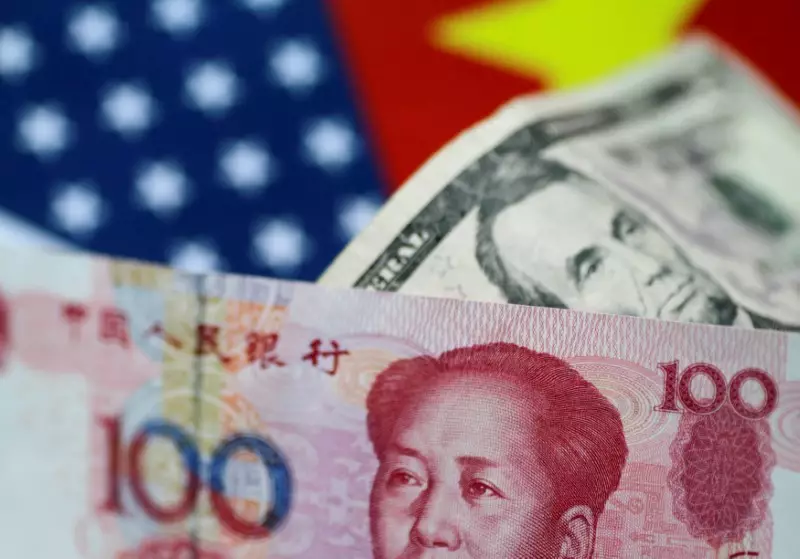The global currency market is experiencing significant upheaval, particularly in Asia, as the U.S. dollar strengthens in response to escalating trade tensions. The recent political landscape, marked by aggressive tariff threats from incoming U.S. President, Donald Trump, has left market participants jittery and has set the stage for potential disruptions in trade relations. This article seeks to dissect the pressures affecting the Asian currency market and to explore the broader implications for global trade.
The Impact of Tariff Threats on Currency Valuations
On Monday, the Chinese yuan plummeted to a four-month low against a surging dollar. This decline was heavily influenced by Trump’s social media post, where he threatened to impose substantial tariffs—up to 100%—on nations part of the BRICS group, which includes Brazil, Russia, India, China, and South Africa. Such a stark warning has raised alarms regarding the stability and sustainability of trade relations, not only among these countries but also across the broader global market.
The immediate reaction in Asian currencies was palpable, with many experiencing sharp declines. Speculation regarding the consequences of these tariffs has spilled over into market sentiment, pushing investors towards safer assets like the U.S. dollar. Consequently, the U.S. Dollar Index surged by 0.5%, reflecting its status as a haven amid uncertain economic conditions. This shift underscores the reliance of many investors on the dollar as a bulwark against volatility, especially in regions vulnerable to the repercussions of U.S. policy shifts.
Within Asia, the South Korean won and the Japanese yen were among the hardest hit, experiencing notable appreciation of the dollar against them. The USD/KRW pair rose by 0.7%, while the USD/JPY pair grew by 0.6%. Such movements can be attributed to not only external pressures but also internal economic conditions that may not favor a rapid recovery. Other currencies, including the Singapore dollar and the Thai baht, followed suit with a decrease of 0.5% each, reflecting a broad trend of depreciation in response to external shocks.
Conversely, the Indian rupee managed to slightly gain ground against the dollar, with its value growing by 0.2%, though it was still under pressure from disappointing GDP growth data that revealed a slowdown compared to previous quarters. Nevertheless, India retains the title of the fastest-growing major economy, outpacing China’s growth rate in the same period, which may lend some resilience to its currency amidst this volatile environment.
Despite the yuan’s recent eye-catching declines, there were glimmers of positive economic reports. China’s official manufacturing PMI for November indicated modest growth, suggesting potential recovery in factory output, supported by the aggressive stimulus measures implemented earlier. Nevertheless, the yuan’s struggles cannot be overlooked, with a 1.8% decline against the dollar last month exacerbated by the prevailing trade war concerns.
Investors are left grappling with the paradox of positive economic indicators juxtaposed against the backdrop of deteriorating trade relations. While the PMI data offers hope, fears of intensified tariffs and the resulting repercussions on exports cast a long shadow over China’s economic prospects.
As we approach critical economic data releases, market participants are keenly awaiting speeches and decisions from central banks. The Federal Reserve’s anticipated quarter percentage rate cut in December is projected to shape market dynamics, but the uncertainty surrounding subsequent rate adjustments remains a key factor. Investors will be focused on statements from Fed Chair Jerome Powell for further insights into the Fed’s likely monetary policy path.
In the Asia Pacific region, the Reserve Bank of India’s decision on interest rates will also be closely watched, especially amidst sticky inflation rates. Australia’s upcoming GDP data is set to add another layer of complexity to the region’s economic picture.
The current landscape of the currency market is indicative of larger geopolitical tensions affecting economic stability. As countries navigate the ever-shifting terrain of global trade agreements and internal growth challenges, both investors and policymakers must brace for ongoing volatility. Cross-border currency movements highlight the interconnectedness of global economies, emphasizing the need for strategic approach when engaging in international trade. The coming weeks will likely prove crucial as stakeholders strive to interpret economic signals amidst the quagmire of shifting monetary policies and burgeoning tariff threats.

